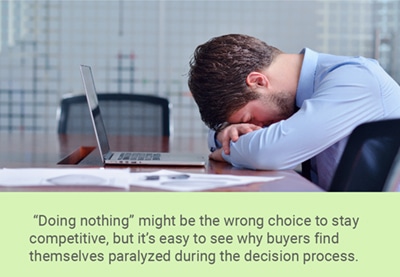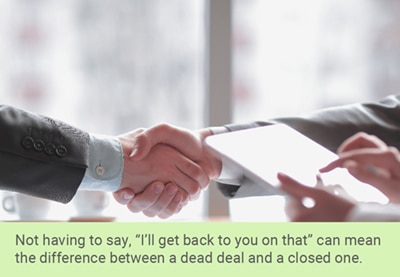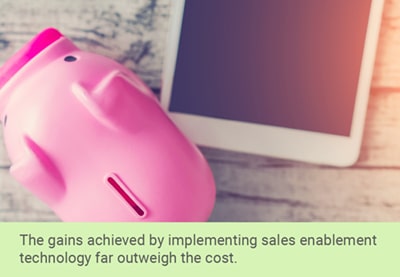There’s no question that employing technology to operate more efficiently and effectively is an investment. But as digital transformation charges on, nothing is as costly as choosing the status quo. If your philosophy remains “the way we’ve been doing it for years,” you’ll not only miss out on revenue, you’ll risk losing it.

There’s good news. The changing buyer journey has created an opportunity for sellers to change the conversation – from product-focused pitch to value-based purpose – and easily justify the value of a sales enablement investment. Why? Measurable ROI, of course.
5 Ways to Justify the Cost of Sales Enablement
1) Traditional sales onboarding is ineffective. On average, new sales hires spend 10 weeks in training and development and only become productive after 11.2 months [Brainshark]. If they’re not productive, they’re not meeting quotas. They’re not making money, and you’re missing revenue targets. What do sellers do when they don’t feel they have the resources to perform? They leave. According to SiriusDecisions, the opportunity cost of sales turnover exceeds $100,000 per seller.

2) The price of noncompliance is growing. A recent report by The Ponemon Institute and GlobalScape states the annual cost of non-compliance to businesses now runs an average of $14.8 million. How can organizations in heavily regulated industries make frequent updates to content in line with always-changing regulations and ensure sellers are actually putting the most accurate and up-to-date information in front of clients?

3) You’re leaving money on the table. Did you know the likelihood of selling to an existing customer is 60-70% versus 5-20% for a new prospect? [For Entrepreneurs] It’s easier and more profitable to upsell or cross-sell to existing customers than it is to sell into new accounts. But sales reps find this increasingly challenging as more companies shift from a specialized to generalist sales model, where sellers are not only expected to know a product category but often the entire product catalog.

4) Value selling works. According to Corporate Visions, 74% of buyers purchase from the first salesperson to provide value. Simply put, if your rep is pitching products and your competitor is quantifying the impact their offering will have on the buyer’s business, it’s likely you’ll lose. Modern buyers expect modern sales conversations that are tailored to their individual preferences, interests, behaviors, and ultimately, business challenges.
Quantifying your value in the context of what buyers care about is the only way to cut through the noise and get customers to the last mile of the sale. Sales enablement technology that leverages interactive value selling tools like ROI calculators, TCO and product comparisons, or benchmark assessments is key to presenting content in a consumable, customizable way that meets buyers where they are with exactly what they need – insights.
5) Channel sales are a major contributor to B2B revenue. According to a Forrester Consulting report, commissioned by Mediafly, partner sales contribute to nearly half (49%) of annual revenue for B2B firms. A consistent brand message matters. If you’re selling through distribution channels, your channel partners are an extension of your sales force – treat them as such!
Offering partners access to the same sales enablement tools and technologies helps you optimize your channel for consistent and impactful buyer engagements. It also makes it easier for them to sell your products and helps you build mindshare with distributors who may also carry your competitors’ products. According to a Forrester study, B2B enterprises that invest in sales enablement platforms for partners are:
- 1.5x more likely to report an increase in customer lifetime value
- Up to 2.3x more effective at achieving sales goals
- 2.1x more likely to report double-digit revenue growth
- Report 1.4x higher revenue growth



Comments are closed.